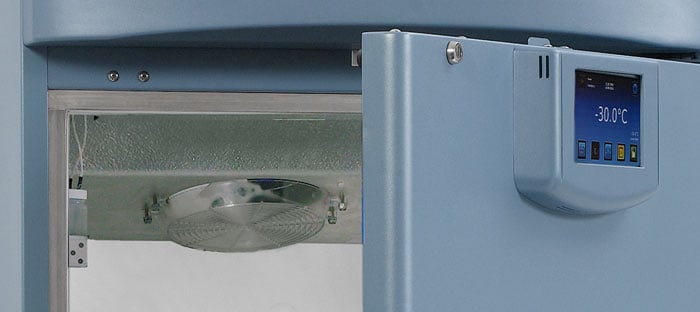
It can be confusing for a laboratory to choose between manual defrost and auto-defrost freezers. A commonly held belief is that manual defrost freezers are the best choice for storing certain sensitive biological materials such as enzymes. Traditional auto-defrost freezers utilize slight intermittent warming of the cooling coils during defrost cycles. The concern is that even this minimal warming has a significant impact on freezer temperature. Ideally, a laboratory freezer used for storing very sensitive, and sometimes irreplaceable, samples would have the best characteristics of both technologies. In this scenario:
- The labor-intensive process of manually defrosting a freezer would be eliminated
- The need to transfer sensitive samples to another freezer during a manual defrost, exposing them to higher temperatures, would be eliminated
- A very tight temperature would be maintained at all times, including during door openings and auto-defrost cycles
We set out to evaluate the impact of both manual and auto-defrost technologies. A study was conducted to evaluate the performance of both technologies by testing sample temperature variability during the auto-defrost process as well as during routine door openings. Door openings were tested to better understand how sample temperature is affected when the door is opened for both auto-defrost and manual defrost units.
Sample Temperature During Auto-Defrost Cycles
First, in order to test the impact of auto-defrost cycles, sample temperatures were measured over a 24 hour period on a Helmer Scientific auto-defrost freezer set to -30ºC and then again at -20ºC. Three defrost cycles were performed during the test period. The results of the study showed that the Helmer Scientific freezer’s automatic defrost cycles had very minimal impact on sample temperatures. During any auto-defrost cycle in a Helmer Scientific freezer, sample temperatures increase by no more than 2ºC in any location within the freezer.
Sample Temperatures During Door Openings
Routine door openings are important because they can have a dramatic impact on sample temperatures. Every time a freezer door is opened, warm air and moisture rush into the cabinet, causing the temperature to rise. Manual defrost freezers (also referred to as cold wall) rely on passive movement of cold air and therefore cannot recover quickly from routine door openings. However, auto-defrost units utilize forced-air cooling. Forced-air actively circulates the cool air inside the unit, enabling the temperature to recover more quickly and effectively.
In order to evaluate the impact of routine door openings, both a Helmer Scientific auto-defrost freezer and another manufacturer’s manual defrost enzyme freezer were subjected to a one-minute door opening test. The results of this test showed that the temperature in the manual defrost freezer spiked higher than in the Helmer Scientific auto-defrost freezer (+7º vs. +4º). In addition, the temperature inside the auto-defrost unit recovered in less than half the time. Results were even more dramatic when doors were opened for one minute every 30 minutes; temperatures inside the manual defrost unit took almost 3 times longer to recover versus the Helmer Scientific auto-defrost unit.
Conclusion
This evaluation proves that the auto-defrost process designed into the Helmer Scientific -30ºC freezer is a more stable and efficient refrigeration system compared to the cold wall unit’s manual defrost process. The impact of routine door openings on samples stored inside a manual defrost freezer far exceeds the impact of auto-defrost cycles in a Helmer -30ºC freezer. In addition, when samples are stored in a manual defrost freezer, they are subjected to significant risk when the freezer has to be defrosted because transferring the samples from one freezer to another exposes them to temperature deviations. With minimal temperature fluctuation during the defrost cycle, quick recovery after door openings, and eliminating the need to move samples for manual defrosting, auto-defrost freezers from Helmer Scientific ensure the safe storage of sensitive biological materials.




